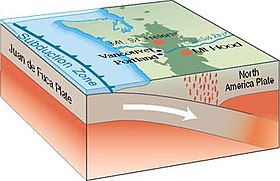Juan de Fuca platter

The Juan de Fuca Plate is a small, purely oceanic lithospheric plate on the northeastern edge of the Pacific Basin at the level of the Canadian province of British Columbia and the US states of Washington and Oregon . It borders the Pacific Plate to the west and the North American Plate to the east . The plate is named after the Juan de Fuca Strait south of Vancouver Island . A Juan de Fuca plate in the broader sense (English Juan de Fuca microplate system ) is to be distinguished from the Juan de Fuca plate in the narrower sense . The latter includes the former and two other small plates , the Explorer plate and the Gorda plate (also called the Gorda region and then not held as a separate plate).
The western border of the Juan de Fuca plate (in the broader sense) is formed by a system of splay ridges that are offset from one another by transform faults (see → Juan de Fuca ridge ). The southernmost of these transform faults, which also forms the southern boundary of the disk system, called Mendocino Fault (Engl. Mendocino fracture zone ). The eastern border is marked by a subduction zone , the Cascadia subduction zone , which is closely linked to the formation of the Cascade Mountains on the North American Plate and the volcanism there . Due to the location of the ridge and subduction zone, the age of the crust of the small plate system increases from west to east. At the subduction zone, it reaches its maximum value at approx. 11 million years (younger Miocene ).
The Juan de Fuca plate (in the broader sense) is an isolated remnant of the Farallon plate , which is now around 2500 km from the nearest Farallon fragment, the Cocos plate . The then even larger forerunner of the Juan de Fuca Plate, which broke away from the Farallon Plate about 55 million years ago along the Mendocino Fault, is called the Vancouver Plate .
See also
Web links
- Anika Bergen: Juan de Fuca, Gorda, and Explorer plates. America's Tectonics. Private plate tectonics website with numerous illustrations from the specialist literature.
Individual evidence
- ↑ a b Joann M. Stock, Jeffrey Lee: Do microplates in subduction zones leave a geological record? Tectonics. Vol. 13, No. 6, 1994, pp. 1472-1487, doi : 10.1029 / 94TC01808 (alternative full text access : Caltech ).
- ^ Rob Govers, Paul T. Meijer: On the dynamics of the Juan de Fuca plate. Earth and Planetary Science Letters. Vol. 189, No. 3-4, 2001, pp. 115-131, doi : 10.1016 / S0012-821X (01) 00360-0 (alternative full text access : Universiteit Utrecht ).
- ↑ US Geological Survey: Why Study Cascade Volcanoes?
- ^ Tanya Atwater, Joann Stock: Pacific-North America Plate Tectonics of the Neogene Southwestern United States: an Update. Pp. 393-421 in: Wallace G. Ernst, Clemens A. Nelson (Eds.): Integrated Earth and Environmental Evolution of the Southwestern United States. Bellwether Publishing, Columbia (MD) 1998, ISBN 0-9665869-0-5 , p. 409.
